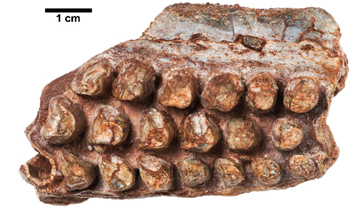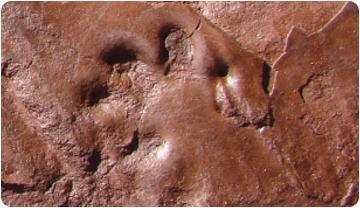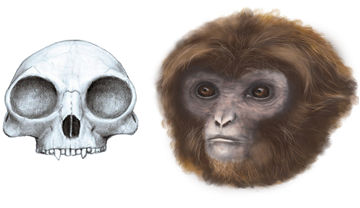
A team of researchers from the Department of Geology at the Universitat Autònoma de Barcelona (UAB) and the Institut Català de Paleontologia Miquel Crusafont (ICP) recently published in PLOS ONE the description of a large set of tracks made by archosauromorphs, reptiles which later evolved into crocodiles and dinosaurs. Among the tracks, there is evidence of a new species, the Prorotodactylus mesaxonichnus, which corresponds to a reptile which lived in the Pyrenees some 247 to 248 million years ago, but which was not related to any dinosaur.
 A fortuitous finding provides first evidence for the presence of a Permian captorhinid reptile in Southern Europe. Belongs to a group of early reptiles which is characterized by the possession of several distinctive tooth rows. Catalan and German researchers collaborated in the study of the fossil, which will be housed at the Museu Balear de Ciències Naturals, at Sóller (Mallorca).
A fortuitous finding provides first evidence for the presence of a Permian captorhinid reptile in Southern Europe. Belongs to a group of early reptiles which is characterized by the possession of several distinctive tooth rows. Catalan and German researchers collaborated in the study of the fossil, which will be housed at the Museu Balear de Ciències Naturals, at Sóller (Mallorca).

Researchers from the Universitat Autònoma de Barcelona (UAB), the Miquel Crusafont Catalan Institute of Palaeontology (ICP), and the Jaume Almera Institute of Earth Sciences (CSIC), working in the Manyanet Valley (Pallars Jussà, Lleida), have identified various tracks made by tetrapod animals between 280 and 290 million years ago, which makes them the most ancient fossil footprints in Catalonia. They correspond to different groups of primitive reptiles and amphibians, among which are synapsids, the group that would later give rise to the mammals.
 A team of researchers from the ‘Institut Català de Paleontologia Miquel Crusafont’ describes in the Science magazine the new genus and species, Pliobates cataloniae, based on a skeleton recovered from the landfill of Can Mata (els Hostalets de Pierola, Catalonia, Spain). The fossil remains belong to an adult female individual named “Laia” by her discoverers. “Laia” weighed 4-5 kg, consumed soft fruit items and moved through the forest canopy by climbing and suspending below branches. Pliobates lived 11.6 million years ago and precedes the divergence between hominids (great apes and humans) and hylobatids (gibbons), which has important implications for reconstructing the last common ancestor of both groups.
A team of researchers from the ‘Institut Català de Paleontologia Miquel Crusafont’ describes in the Science magazine the new genus and species, Pliobates cataloniae, based on a skeleton recovered from the landfill of Can Mata (els Hostalets de Pierola, Catalonia, Spain). The fossil remains belong to an adult female individual named “Laia” by her discoverers. “Laia” weighed 4-5 kg, consumed soft fruit items and moved through the forest canopy by climbing and suspending below branches. Pliobates lived 11.6 million years ago and precedes the divergence between hominids (great apes and humans) and hylobatids (gibbons), which has important implications for reconstructing the last common ancestor of both groups.






